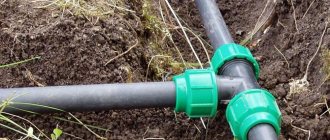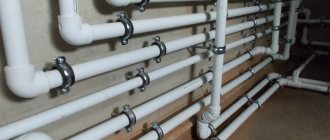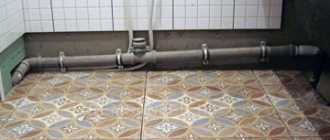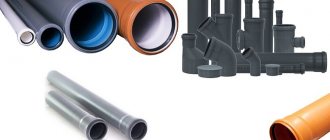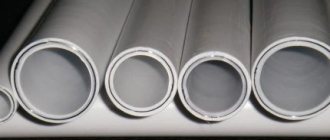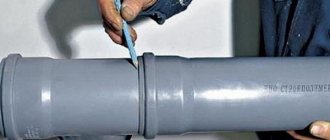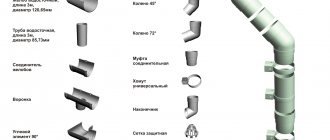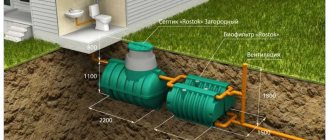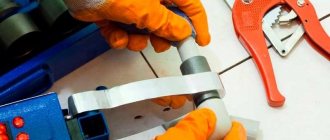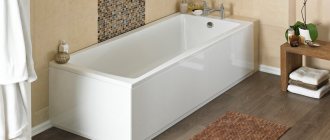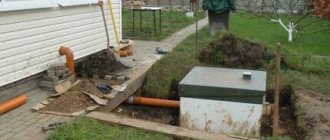Low-density polyethylene occupies a leading position in the popularity ranking among materials used for pipeline assembly. The secret of such demand is easily explained by the versatility of use and ease of installation of polyethylene pipes.
But as when working with any other polymer, high-quality installation of HDPE pipes with your own hands can only be done subject to strict adherence to technology. We will tell you what nuances to consider when joining elements. We will explain how to correctly bend and straighten them.
Advantages and disadvantages of HDPE pipes
Low pressure polyethylene is an organic polymer of ethylene. Designated PE or PE. It is white in color (thin-layer products are transparent). The concept of “low-density polyethylene” has nothing to do with the density of the material or operating conditions, but characterizes the production conditions.
HDPE pipes are painted black, gray, blue or black with blue stripes. Blue color or blue stripe indicates that the pipes can be used for potable water lines.
The scope of application of HDPE is for cold water pipelines, some aggressive media (with the exception of diluted nitric acid), and sewer systems. Diameters reach up to 1600 mm. Very widely used for cold water and sewerage pipelines.
They are used in wiring cables and wires for power supply, communications, and the Internet as casings (smooth products and corrugated).
Advantages of HDPE as a material for pipelines:
- durability - the first plastic pipelines made of HDPE have already worked for more than 50 years;
- low price;
- frost resistance - withstands freezing with water in winter and thawing in spring and maintains integrity;
- chemical inertness – resistant even to concentrated alkalis and acids; the water in the pipes does not acquire an unpleasant odor or taste;
- corrosion resistance;
- smooth walls with low adhesion prevent salts from settling on the walls;
- harmlessness to humans;
- environmental friendliness - harmless production, easy disposal;
- strength;
- flexibility - bends easily (when heated, you can even bend it with your hands);
- high impact strength, ductility and, as a result, resistance to hydraulic shocks, lack of fragility, ability to recover from deformation;
- simple maintenance – plastic is easy to clean, it does not require regular painting or anti-corrosion treatment;
- low weight facilitates transportation, folding, installation;
- easy to install - no need for complex equipment (for example, a welding machine); easy to cut; easily joined in different ways.
Disadvantages of HDPE:
- the most “inconvenient” drawback is poor ultraviolet resistance. PE is destroyed in the light and is not applicable to open laying in the light under the open sky. Of course, you can put it in covers and boxes - but this is an extra expense and a waste of time; however, the pipes will “live” in the garden for 2-3 seasons
- low heat resistance - PE pipes can only be used for cold water and at temperatures up to a maximum of 60°C (unlike polypropylene and cross-linked polyethylene pipes, which can be used for heating systems), as a result - long suspended sections of PE pipes sometimes sag in heat;
- not very high aesthetics - black-striped or black pipes in bathrooms and kitchens are not our taste;
- working pressure up to 20 MPa limits the use of polyethylene in industry;
- reinforced pipes have less flexibility.
Laying communications in a trench
It is not difficult to protect your country water supply system from mechanical damage if you use the trench method of laying HDPE pipes.
The simplest option: laying pipes in a shallow trench. Next, the pipe is covered with earth, and this ensures its safety and minimizes the impact of ultraviolet radiation from sunlight. A water supply pipe laid in a trench is easy to dismantle if necessary. Of course, hiring a team to dig trenches is an additional financial cost. The only way to save money allocated for the installation of a water supply system from HDPE pipes is to do everything yourself, including land work.
HDPE pipes are destroyed under the influence of ultraviolet radiation, so they must be covered with earth
A higher priority method is to install a water supply pipe at the dacha in specially prepared trenches, complemented by drainage trays and technological covers. The tray protects the pipe from deformation and damage, and works as a simple drainage system. Covers with ventilation holes will prevent condensation from forming on the surface of the pipes.
A trench supplemented with a heating cable along the outer part of the water supply will allow the effective use of cross-linked polyethylene pipes even at negative temperatures, for example, in winter. In this case, energy bills will increase; the heating cable is connected in the same way as the pumping group to the electrical network.
Important ! For ease of operation, it is customary to equip drainage units with shut-off valves. A properly laid water supply system for a dacha, assembled with your own hands, has a bias towards the end user, and is complemented by a drain valve that ensures water is drained from the system before dismantling, or during the off-season period.
Installation methods
Installation of polyethylene lines can be done using a detachable or permanent method. The choice of method depends on the diameter and sealing requirements.
Butt welding of pipes
Butt welding is carried out only on products with a wall thickness of at least 3 mm, preferably 5 mm or more. This is a very common, simple, cheap and reliable docking method. It is used practically on pipes with a diameter of 50 mm or more (with smaller diameters the wall thickness is insufficient for welding).
A type of welding is butt welding of all kinds of adapter fittings onto metal for connecting metering units or water points...
Permanent connection
Permanent connections are used where increased requirements for the tightness of connections are required (for example, gas pipelines) and on large diameters, where the connection through fittings is not entirely reliable. For connecting large diameters this is the only possible way.
HDPE pipes are connected using diffusion butt welding (and diffusion welding of fittings) and welding using thermistor couplings.
Electrofusion welding is a very expensive pleasure and when laying a system, for example, a water supply, the price of the couplings will be higher than the cost of the rest of the system. For large diameters, the cost of couplings is generally exorbitant, as is the cost of the welding machine.
The soldering method itself is simple: the pipes are cut, stripped, inserted into the coupling, the coupling with heating elements is connected to the welding machine and heated, the inner surface of the coupling and the outer surface of the pipe blank are soldered into one whole. But perfection is very expensive - and despite the simplicity of the method, we will not describe its technology in detail.
Plug-in connection
Detachable connections using fittings and detachable couplings are used on diameters up to 315 mm, preferably used on small diameters - up to 110 mm. On large diameters, due to the high plasticity of HDPE, the connection is less reliable and may leak. There are two ways of detachable connections: using fittings and couplings. Advantages of the method:
- quick and simple installation, accessible even to a non-specialist;
- affordable price - couplings and fittings are not too expensive;
- high tightness, sufficient even for gas pipelines;
- can be used in inconvenient places or with some other difficulties (for example, you can assemble a pipeline under water).
With fittings
There are compression fittings, press fittings (press-fitting), push fittings.
Assembly using compression fittings is very simple, without special tools and provides a reliable dismountable connection. The fitting consists of a collet (threaded body), thrust and O-rings, and external crimp nuts. The pipe is firmly clamped between the body and the crimp nut, the connection is sealed due to the plasticity of the HDPE and the O-ring.
Press fittings consist of a press sleeve, a body, a thrust ring and an O-ring. The connection is permanent, very reliable and highly airtight. This method is used for gas pipelines and underfloor heating systems. Using a small hand press, the press sleeve is crimped, pressing the end of the pipe onto the inner sealing ring of the housing.
Push fittings are a recent invention of marketers. They allow you to quickly assemble a system without any tools at all. The result is a permanent connection, but the fitting rotates on the pipe - this connection cannot be used for gas pipelines or closed systems (warm floors). They are expensive - more expensive than compression fittings, press fittings and detachable couplings.
coupling
A connection method that does not require special equipment. Polyethylene couplings come in several types:
- according to the functions performed - connecting (for one diameter), reducing (transition from diameter to diameter), transition - have on one side a pipe with a metal thread for connecting taps, mixers, meters, filters and connections with pipelines made of another material;
- in shape - straight, angular, tees, etc.
Also worth mentioning are flange connections on pipelines with a diameter of at least 50 mm. Special threaded couplings are welded to the ends of the pipes, and flanges are screwed on. This connection is used when installing valves, valves, and meters.
Which way is better
The choice of connection method is influenced by many factors. If we are talking about pipelines for a house, apartment, or site, then products with a diameter of up to 50 mm are usually installed; such diameters are not welded, and the choice is made of couplings and fittings with almost the same properties. The choice is yours.
Ordering and purchasing products at wholesale prices
The technology for installation and welding of HDPE pipes and fittings must be strictly observed - only in this case the equipped system will serve for decades, without requiring repairs or maintenance. However, in addition to strictly following the instructions, the quality of the pipes and fittings themselves also plays a big role.
is one of the largest manufacturers of pipes and equipment in the Far Eastern region. Production is carried out in our own production from high-quality foreign raw materials. Thanks to strict quality control, all types of products meet safety and reliability requirements, which is confirmed by relevant certificates and licenses.
We offer to purchase HDPE pipes, fittings, welding equipment and other products at wholesale prices from the manufacturer. The cost of a wholesale batch of goods is calculated for each client individually by the manager of our company. We guarantee exceptionally favorable prices for you and high quality of all products. You can send a request or ask clarifying questions using the feedback form or the telephone numbers listed on the website.
Do-it-yourself installation of HDPE pipes
Self-installation of pipelines made of low-density polyethylene is quite accessible even to an inexperienced home craftsman. The use of fittings and couplings does not require special equipment.
Required tools and materials
To perform the installation yourself you will need:
- special scissors for cutting pipe blanks (you can use a grinder);
- To install press fittings you will need a manual mechanical crimping press (press pliers) see photo;
- perforator for punching passages in walls;
- two adjustable wrenches (when installing compression fittings);
- calibrator;
- round file.
Drawing and diagrams
Before installing a polyethylene system, you should carefully consider the installation location, select the appropriate diameters, and decide on the location of the connection to the metering unit and water collection points. Competent design and a drawn plan will minimize the consumption of materials and components, stage-by-stage planning will optimize installation time.
The scope of application of polyethylene communications at home is underground and basement communications, and choosing the optimal placement of the pipeline will allow you to reduce the volume of excavation work to a minimum.
Work order
Before starting work, preparation is necessary: collect materials and tools; cut workpieces; use a file to cut off burrs; Wipe the ends with a rag to remove dirt and shavings.
Assembling connections using compression fittings is carried out as follows: an unscrewed crimp nut is put on the workpiece, the end of the workpiece is inserted into the fitting, and the nut is tightened until it stops by hand. Then the fitting body is clamped with a wrench, and the nut is tightened with a second wrench: for workpieces with a diameter of 32 mm by one turn, with a diameter of 25 mm - by a turn and a quarter.
Installation of pipes using collet couplings is similar to assembly using compression fittings (due to the similarity of design).
Assembly using press fittings is performed in the following order:
- first, a press sleeve is put on (on the end of the pipe);
- the inner sealing ring of the housing is inserted inside the pipe;
- the sleeve is clamped with hand press clamps;
- then the handles of the press are clamped with force (all the way). Then the handles are released and the press is removed. Deep ring-shaped dents are imprinted on the sleeve.
Preparatory work
Purchase the necessary connections
Before you begin installing HDPE pipes, you must:
- Make a sketch or plan of the future route and measure its length. Also count the number of drops and turns.
- Determine how much material you will need for the job and purchase it at the store. Don't forget about the mounting clamps.
- Prepare the necessary set of tools that should be at hand.
- Turn off the indoor water.
- When connecting new pipes from an old metal system, it is necessary to place a connecting fitting on the metal pipe, which will serve as an adapter.
- Then you should cut the pipes into pieces of the required length using a pipe cutter or a hacksaw. Maintain a 90 degree cutting angle. The ends must be cleaned after cutting.
When you have done all this, you can proceed directly to installation.
How can you bend and straighten a HDPE pipe?
HDPE pipes of small diameters can even be made by hand. When laying underground, where aesthetics are not required, it is better to heat the desired area with a hairdryer and carefully bend it without any mandrel - in this case, the bend will have a large radius, but the stress in the pipeline will be minimal. If neat bends of small diameter are required, after heating, you should carefully place the workpiece in a mandrel made from any available materials.
Let cool for at least 15 minutes. You can use a pipe bender, but since polyethylene is a very plastic material, there is no particular need to use it.
If the material is supplied in coils, then the pipe should be stretched in the sun, allowed to warm up and stretch. Or use a hair dryer.
Fasteners
For the pipeline to work reliably, it must be secured. This can be done in two ways:
- using fastening hooks – free fastening;
- using special clamps - rigid fastening.
Rules for installing fasteners:
- each joint must be fixed;
- on straight sections, fasteners are installed at a distance equal to 10 pipe diameters;
- rigid fastening is carried out using clamps with a rubber gasket;
- free - either on hooks (you can make your own), or in clamps, but without a rubber gasket.
Note! Loose fastening of HDPE communications will allow the pipes to move in the event of vibrations, water hammer, and temperature changes. This facilitates pipeline maintenance and extends their service life.
Possible installation errors
Errors can occur when connection rules are violated:
- failure to maintain the distance between fasteners;
- incorrect heating time, excessive force during welding;
- rigid fasteners, without taking into account the linear expansion of materials.
Trial run
The development of the land plot and the digging of trenches is carried out only after a trial run. Water is released into the laid pipeline; do not forget to open the taps, since the filling should occur gradually and the air will be forced out of the system. Start the pump and check for leaks and no leaks at the connections. If there is leakage, damaged areas must be replaced.
If you want to install a year-round water supply with your own hands, you will have to spend a lot of effort and time to provide for all the nuances. The assembly process in the presence of dug trenches should not take more than 1 day. The main thing is not to bury the laid pipes right away; it is necessary to conduct a test run to inspect for leaks. Do not forget about the complete tightness of the system. If the pressure is unstable, this will lead to water leakage and rapid failure of the pumping station. Be careful when carrying out work.
Video about the construction of a summer water supply system at a dacha using pipes. Why did I have to change PVC pipes to HDPE?
Electrofusion welding
The welding procedure, which involves the use of special fittings and installations, places high demands on the preparation of the ends and simplifies work in hard-to-reach places.
To install pipelines using electric couplings, you will need to perform a number of operations:
- cut pipes taking into account the depth of the fittings;
- carry out mechanical and chemical treatment of cuts, removing irregularities and contamination;
- insert the prepared edges into the sleeve;
- connect the contact wires of the welding machine to special connectors on the fitting;
- activate the welding process.
The duration of the current supply is determined by the coupling parameters. The barcode on the product helps to set the indicator correctly.
